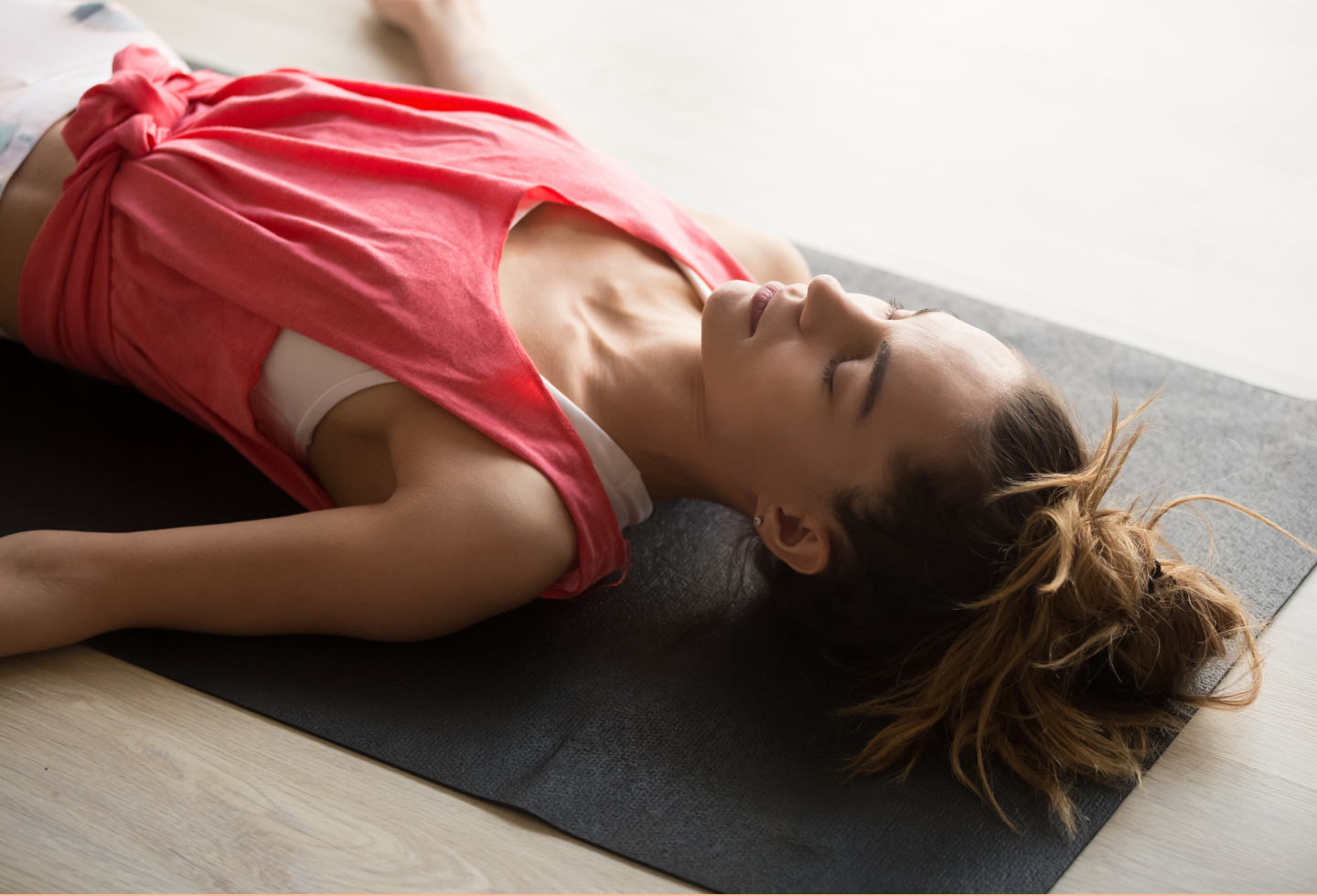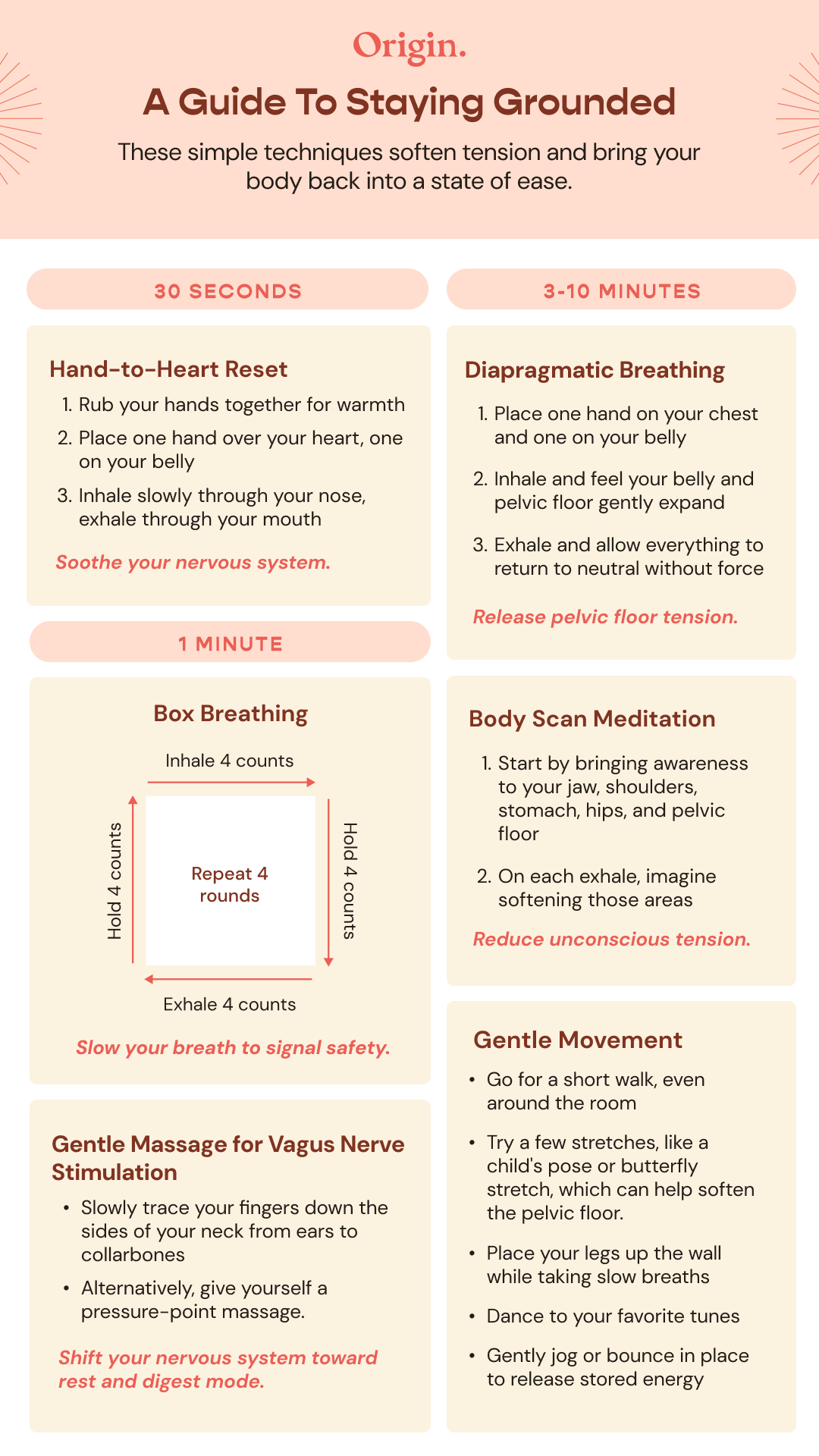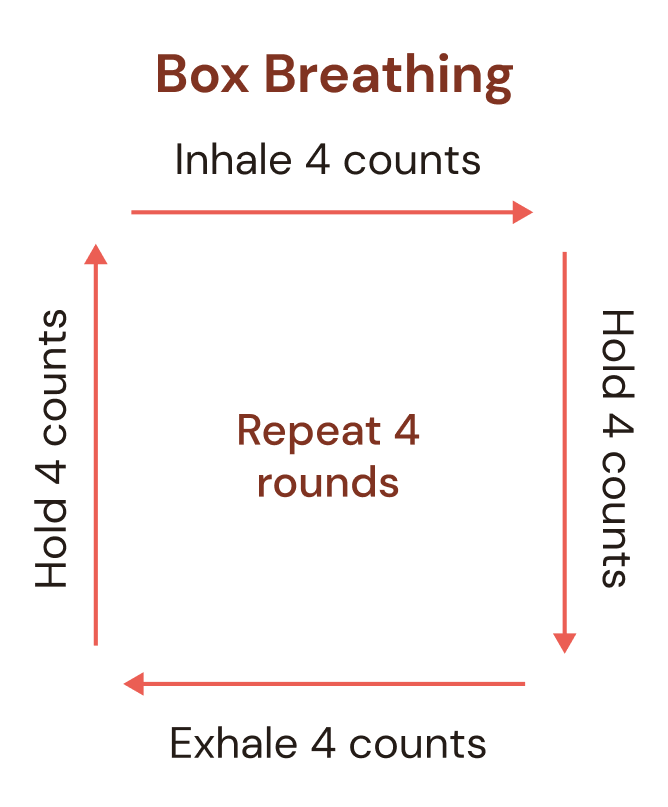
A Guide to Staying Grounded this Holiday Season
The holiday season often brings moments of joy, connection, and celebration, but can also lead to overwhelm. Travel, hosting, shifting routines, and heightened emotions can put added stress on your body. When the body senses this stress, it activates your sympathetic nervous system, sending your body into a fight-flight-or-freeze state. As a result, breathing can become shallow, muscles begin to tense, and the pelvic floor often tightens in response.
If you notice yourself feeling unsettled, on edge, or disconnected this time of year, you’re not alone. Thankfully, your body’s parasympathetic nervous system is a built-in system for restoring calm, which supports rest, grounding, and a return to homeostasis.
This guide offers simple, realistic practices that use breath, movement, and pelvic floor awareness to help bring your body back into balance. Each practice is quick and can even be performed in the midst of holiday activities, whenever you need it.
How Stress Affects the Pelvic Floor
You may notice stress appear as tension in different parts of your body, such as your jaw, shoulders, or stomach. For many people, the pelvic floor can respond to stress in a similar way, tightening when we feel overwhelmed.
When your nervous system senses stress, the hypothalamus activates both the sympathetic nervous system (SNS) and the hypothalamic-pituitary-adrenal (HPA) axis. The SNS responds quickly while the HPA axis follows with a slower, more sustained release of cortisol. Together, these systems can lead to increased muscle tension throughout the body.
The pelvic floor, which plays a key role in core support, bladder and bowel control, sexual function, and more, commonly responds by contracting.
When your body carries around stress, the pelvic floor can remain in a tightened state, which can contribute to urinary urgency, difficulty fully emptying the bladder, constipation, pain, or discomfort with sex. Stress can also heighten how the brain interprets pain signals, which can create a cycle of tension and discomfort that feeds into itself.

Fortunately, your body has a natural calming system called the parasympathetic nervous system. One of the main pathways that helps activate it is the vagus nerve. The vagus nerve is a bridge between the brain and the body. It influences breathing, heart rate, digestion, and emotional processing. When it is stimulated, it helps shift the body out of a fight or flight state, allowing you to unwind, rest and restore a sense of safety.
When the parasympathetic nervous system turns on, breathing slows, heart rate steadily decreases, and muscles begin to release. This includes the pelvic floor. This is why breathwork, grounding practices, and other nervous system regulation techniques are powerful tools for both emotional regulation and long-term pelvic floor health. They help send a signal to your body that it is safe to soften.
5 Quick (and Easy) Calming Techniques
Long relaxation routines are helpful but unrealistic when you are busy wrapping presents or are finally gathering around the holiday dinner table. Short, mind-body exercises you can do in just a few seconds help activate the parasympathetic nervous system and release tension in the moment.
Below are 5 evidence-based strategies that can be done in as little as 30 seconds. Save this infographic and come back to it when you need it!

1. Box Breathing (1 minute)
Box breathing is a great grounding breathwork technique that can calm your nervous system by encouraging slower breathing, which signals to the vagus nerve that your body is safe.
How to try it:
- Inhale for a count of 4
- Hold for 4
- Exhale for 4
- Hold for 4
- Repeat 4 cycles.

2. Vagus Nerve Stimulation with Gentle Massage (30 seconds to 1 minute)
There are numerous techniques to stimulate the vagus nerve. One way is through acupressure, a technique that applies gentle pressure to specific points throughout the body. A small body of research shows that using reflexology, a type of acupressure that utilizes points on the feet, shoulders, and neck, can decrease the sympathetic stress response and lower blood pressure in some people.
Try one of the following:
- Give yourself a pressure-point massage. Here’s how!
- Slowly trace your fingers down the sides of your neck from ear to collarbone.
- Pop a cold pack (at between 50-65 degrees Fahrenheit) to the sides of your neck (near where you’d check your pulse at the carotid artery) for about 15 seconds. Repeat this 4 times!
- Rub your hands together for warmth and place one hand over your heart and one over your belly.
This soothing tactile input helps shift the nervous system toward rest and digest mode.
3. Diaphragmatic Breathing (2 minutes)
If your pelvic floor feels tight or your body feels restless, synchronizing breath to relax the pelvic floor can help. Practicing diaphragmatic breathing when performed properly, can help you tap into your pelvic floor and coordinate those muscles with your breath. This gentle practice can be done while seated, lying down on the couch or really wherever you have a moment to spare.
How to try it:
- Start by placing one hand on your chest and the other on your belly.
- Inhale, feeling your belly widen as your breath moves downward into your entire pelvic floor and the chair supporting you, and gently expands through your back. Tip: With each inhale, imagine your pelvic floor lengthening like the bottom of a balloon as it inflates with air.
- As you exhale, let the air leave your body naturally without forcing it. With time and attention, you’ll feel your belly and pelvic floor slowly return to where they started.
- Repeat!
This movement helps the diaphragm and pelvic floor work together to support calm regulation. You can also engage in this practice with your legs up the wall to promote an added feeling of calm and relaxation.
Learn more about how breathwork can support your pelvic floor.
4. Body Scans (1-10 minutes)
Research shows meditation and mindfulness practices like body scans are incredibly effective at activating the parasympathetic nervous system, which in turn calms your body.
Body scans can be a powerful tool to help turn your attention inward to what’s happening in your body, drawing awareness to your breath, thoughts, and physical sensations you’re experiencing. Particularly when your body is in a heightened state of arousal (or stress), body scans help ground you to what’s happening and usher in calm.
Try this guided pelvic floor meditation created by an Origin physical therapist, which reinforces the mind-body connection and encourages a moment of calm.
5. Gentle Movement to Release Tension (1–10 minutes)
When stress builds in your body, muscles, including the pelvic floor, may tighten. Gentle movement helps release that tension and lets energy move through instead of staying stuck.
You don’t need a full workout. Even a minute or two of intentional movement can shift your nervous system and help your body return to a sense of ease.
Choose the movement that feels most supportive right now:
- Go for a short walk, even around the room
- Try a few stretches, like a child's pose or butterfly stretch, which can help soften the pelvic floor.
- Dance or sway to your favorite holiday tunes
- Gently jog or bounce in place to release stored energy
Movement helps your body discharge stress, oxygenate muscles, and reduce pelvic floor tension by reminding the nervous system that it’s safe to let go. Return to this anytime your body feels “stuck,” restless, or tight.
Staying Present
Presence is not something we force. It is something that emerges once your body feels safe.
Small, repeated grounding practices build capacity to relax over time. If you have moments this season where you feel disconnected, overwhelmed, or tense, try to return to your breath, your senses, and your body for calm. The nervous system is willing to come back into balance with the right support.
If movement is part of how you release stress, you might also consider how you work out. Inter-repetition rest resistance training (IRRT) has been shown to place less stress on the body compared to traditional continuous-rep strength training. In IRRT, adding brief, 15-30 second rests after each rep can help you get the benefits of strength work while keeping your nervous system steadier and more supported (we love a rest)!
Need More Support?
If pelvic floor tension and stress-related symptoms are interfering with your ability to be present, our team is here to help. Book a visit with an Origin clinician to calm your nervous system and reconnect with your body.
Sources
Bassam Khoury, Tania Lecomte, Guillaume Fortin, Marjolaine Masse, Phillip Therien, Vanessa Bouchard, Marie-Andrée Chapleau, Karine Paquin, Stefan G. Hofmann, Mindfulness-based therapy: A comprehensive meta-analysis, Clinical Psychology Review, Volume 33, Issue 6, 2013, Pages 763-771, ISSN 0272-7358, https://doi.org/10.1016/j.cpr.2013.05.005.
Harvard Health Publishing. “Understanding the Stress Response.” Harvard Health, 3 Apr. 2024, www.health.harvard.edu/staying-healthy/understanding-the-stress-response
Jing, Yunyan, Shanxin Liu, Chunqi Pan, Ying Jian, Mingwei Wang, and Bin Ni. “The Effects of Foot Reflexology on Vital Signs: A Meta-Analysis of Randomized Controlled Trials.” Evidence-Based Complementary and Alternative Medicine, vol. 2022, article 4182420, 13 Sept. 2022. Hindawi, doi:10.1155/2022/4182420.
Kassiano W, de Vasconcelos Costa BD, Lima-Júnior D, Gantois P, de Souza Fonseca F, da Cunha Costa M, de Sousa Fortes L. Parasympathetic Nervous Activity Responses to Different Resistance Training Systems. Int J Sports Med. 2021 Jan;42(1):82-89. doi: 10.1055/a-1219-7750. Epub 2020 Aug 25. PMID: 32842156.
Lee, Yun-Mi. “Effect of Self-Foot Reflexology Massage on Depression, Stress Responses and Immune Functions of Middle-Aged Women.” Journal of Korean Academy of Nursing, vol. 36, no. 1, 2006, pp. 179–188. Korean Soc. of Nursing Science, doi:10.4040/jkan.2006.36.1.179. JKAN+1
Lu, Wan-An et al. “Foot reflexology can increase vagal modulation, decrease sympathetic modulation, and lower blood pressure in healthy subjects and patients with coronary artery disease.” Alternative therapies in health and medicine vol. 17,4 (2011): 8-14.
Mínguez-Esteban I, De-la-Cueva-Reguera M, Romero-Morales C, Martínez-Pascual B, Navia JA, et al. (2024) Physical manifestations of stress in women. Correlations between temporomandibular and pelvic floor disorders. PLOS ONE 19(4): e0296652. https://doi.org/10.1371/journal.pone.0296652




